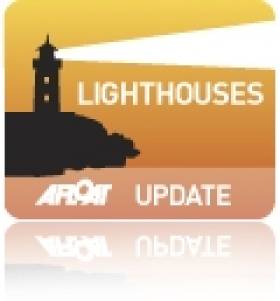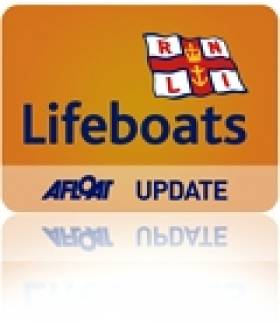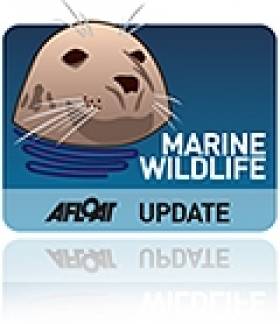Displaying items by tag: Shannon Estuary
Former Irish Lights Dun Laoghaire Harbour Based Buoy-Tender Sports New Shannonside Colours
#BuoyTender - Puffin, a former Commissioners of Irish Lights (CIL) buoy-tug tender which spent a career of almost three decades in Dun Laoghaire Harbour has recently been spruced up in new colours for current owners Shannon Workboats, writes Jehan Ashmore.
Puffin was very much a 'workhorse' for Irish Lights Dun Laoghaire based marine depot from where the vessel towed countless buoys back and forth to the various anchored 'lighthouse' tenders among them Atlanta, Granuaile and Gray Seal.
Arguably such workhorses can be easily forgotten or disregarded in a task perhaps perceived as mundane yet the role of the Puffin was an integral component in ensuring the operations of CIL.
The work of Puffin was vital bearing in mind the countless aids to navigation that dot around our island to assist safe passage not just to seafarers and ship cargoes but also passengers and leisure users too.
The Commissioners had Puffin custom-built from David Abels Boatbuilders of Bristol in 1984. It is understood that the small vessel of 12.4m long, beam of 3.8m and 1.5m draught was the last vessel launched from the Albion Dockyard.
When she was sold in 2011, the 24 gross tonnes vessel made her repositioning delivery voyage from Dun Laoghaire to the Shannon Estuary. The first leg to Baltimore took more than 30 hours and from where she took on bunkers before continuing on the final 20 hour-leg to Foynes.
She alongside Shannon Workboats fleetmate Islander are 'lines-boats' contracted to Rusal Aughinish Alumina, the largest alumina processing plant in Europe. Both workboats provide assistance in transferring mooring ropes between bulk-carriers docking and departing the double berth jetty.
The outer 285m berth can handle 90,000dwt vessels at depths of 12.4 metres and the inner 180m berth is for 40,000dwt ships in waters of 11 metres.
Examples to the type of bulk-carriers both large and small calling to Aughinish Jetty as previously reported on Afloat.ie are the 2009 Japanese built Panama-flagged Aom Julia, the 76,596dwt which was discharging bauxite. On the adjacent berth the South Korean built Arklow Mill of 14,990dwt was loading alumina bound for Rotterdam.
The plant's production process involves extracting alumina from imported bauxite that is discharged at the jetty. Approximately 70% of the bauxite originates from Guinea in west Africa and the balance from Brazil. The alumina (totalling 1.924m tonnes in 2012) is discharged from the same jetty for export where it is processed again through smelting into aluminium metal.
The lighthouse vessels are now referred as aids to navigation tenders with the current vessel the 2000-built ILV Granuaile. The 2,635 gross tonne vessel continues to anchor within the harbour's western bight off the West Pier. Instead of the Puffin, the towage of buoys continues to be maintained by smaller sized tenders belonging to the ILV Granuaile.
On a few occasions each year due to Spring tides, this procedure is not required as ILV Granuaile can moor alongside the berth at CIL's joint administration and marine depot.
Among the other tasks Puffin was gainfully employed was in the towage of the larger navigational aids such as Superbuoys and Large Automated Navigation Buoy's (LANBY). In 2010 Afloat.ie reported on the last LANBY.
In addition Puffin was not exclusively confined within the harbour as she would be required to transfer maintenance personnel to the automated Kish Lighthouse and Muglins lighthouse off Dalkey Island.
Her aft deck can handle up to 5–tonnes capacity and has proved useful. For example she loaded dismantled parts no longer required within the structure of the Kish Lighthouse and taken to Dun Laoghaire Harbour.
Puffin not only retains her original name but also her port of registry – Dun Laoghaire which is certainly most unusual to see for a vessel that is not a pleasure craft or yacht.
With the removal of Puffin's former CIL livery of grey hull colour and buff funnel, which also applied to the lighthouse tenders, the last been in this guise was the 1970 built Granuaile.The 2,003grt vessel as previously reported on Afloat.ie serves as Ocean Seeker for Gardline Marine Services based out of Great Yarmouth on the UK's Norfolk coast.
The current 'Granuaile' sports a blue hull likewise to her former fleetmate... the Puffin!
Loop Head Lighthouse Attracts 19,000 Visitors
#loophead – Figures released today show that over 19,000 people (14,101 adults, 5,082 children) visited Loop Head Lighthouse during the six-month opening period up to Sunday, 29 September.
Clare County Council, which manages the facility in conjunction with the Commissioners of Irish Lights (CIL), said preliminary estimates indicate that 75% of the total visitor figure was represented by domestic visitors, of which approximately 55% were holidaymakers and 30% were day trippers, with local visitors accounting for the remainder. Overseas visitors accounted for 25% of the total figure.
The Lighthouse was opened on a weekend basis from St Patricks Weekend until mid-May after which it was opened daily until the end of September. Opening hours were extended by two hours to 7.30pm during late July and August to accommodate the surge in visitor numbers to the West Clare landmark this summer.
The visitor figures, which represent a jump of 2,000 on the same period in 2012, coincide with the recent announcement that Loop Head Peninsula has been shortlisted alongside Burren & Cliffs of Moher Geopark and 6 other sustainable tourism destinations and organisations in the 'Best Destination for Responsible Tourism' category of the 10th annual 2013 World Responsible Tourism Awards. Other shortlisted locations include Bhutan, Bonito (Brazil) Nature Park & Glacier Region Kaunertal (Austria), Mara Naboisho Conservancy (Kenya), Valleys Regional Park (Wales) and Lithuania in the 'Best Destination for Responsible Tourism' category.
The awards ceremony, which is being hosted by World Travel Market, takes place on Wednesday 06 November during World Responsible Tourism Day, at the ExCeL London Exhibition and Convention Centre.
Loop Head Lighthouse, located at the mouth of the Shannon Estuary, is steeped in history and rich in maritime heritage with its origins dating back to the 1670s. The existing tower style lighthouse was constructed in 1854 and was operated and maintained by a keeper who lived within the lighthouse compound.
Taoiseach Enda Kenny's grandfather was a keeper at the lighthouse. James John McGinley took up duty at the Lighthouse as Principal Keeper on 16th January 1933. He spent 1 year and 10 months at Loop Head. He was transferred from the station in October 1934. In January 1991, the lighthouse was converted to automatic operation, and today is in the care of an attendant and is also monitored by the CIL.
Foynes Yacht Club Applauds Maximus & Marengo September Series Winners
The September series of racing concluded at Foynes Yacht Club on Sunday last writes Gerry Ryan.
The south-easterly wind with 15 knots of breeze ensured that superb racing took place east of Foynes Island. The Officer of the Day, vice commodore, James McCormack set a challenging course for the competitors. In Class 1 the boats raced to the 8 metre mark and back down to Sturamus and back up river to the 8 metre and back to the club finish line.
In the White Sails division the boats were sent to the 8 metre mark and down to Sturamus and home. In Class 1 Darragh McCormack in Maximus received the Dan O'Sullivan Cup; second was Dis-A-Ray, with Ray McGibney at the helm, and third was Battle with John-Paul Buckley as skpper. In the White Sails division, Pat Finucane in Marengo received the John Maher Cup; while Kerry Dream with Commodore Tom Murray on the helm.
The October series for Mermaids will be starting on Sunday next with first gun at 1pm. Racing will take place for the three Sunday's in October and on the Monday of the October bank holiday weekend.
Skipper and crews are asked to be at the clubhouse at 12noon on Sunday for a briefing.
The Royal Western Yacht Club will be hosting the annual October series from next Sunday. Details on this event are available on www.royalwesternyachtclub.com
New Maritime Museum in Foynes Officially Opened by Tourism Minister
#NEWmaritimeMuseum – Foynes Flying Boat & Maritime Museum welcomed Michael Ring TD, Minister of Tourism & Sport who officially opened yesterday the mid-west tourist attraction's new maritime museum.
Minister Ring said "This new Maritime Museum adds greatly to the overall Foynes Flying Boat Museum, and will attract repeat visitors as well as many maritime enthusiasts, keeping Foynes at the forefront of tourism in the Shannon Region and on the new Wild Atlantic Way.
"I am pleased that the Government, through Fáilte Ireland, has provided support to this very worthwhile project under the Tourism Capital Investment Programme.
"I know that the development of a Maritime Museum, that would tell the story of the River Shannon and the influence on the lives of those communities living nearby, has always been a goal of the Museum's management here at Foynes. This ambition has now been realised".
The new maritime section tells the story of one of Ireland's great maritime assets... the River Shannon. The exhibits on display detail the geology, personality and mythology of the estuary stretching from Limerick docks down to Loop Head, marking the mouth of the Shannon at its seaward limits.
As previously reported the diversity of topics on display in the new maritime museum is a combination of interactive technology, artefacts, replica exhibits, and a stunning view of Foynes from the recently reinstated control tower that was used for the trans-Atlantic flying boats.
The tower has a balcony (equipped with bino-cularscopes) where shipping activity can be directly observed from and inside the tower and from where there is a photo-montage outlining the various landmarks of the village and estuary.
The view overlooking Foynes includes Foynes Yacht Club, Foynes Island and in the far distance across the estuary is the Aughinish Alumina processing plant.
During yesterday's opening ceremony, the dry-bulker Foxtrot could be seen at a Port of Foynes berth directly opposite from the observation tower and where cargo was been loaded on board.
Shannon Foynes Port Company (SFPC) earlier this year launched the master plan vision to 2041, which looks forward to the future and the museum is doing its part to preserve the past for the future.
The new addition to the award-winning Flying Boat Museum completes the overall plan that was first envisaged back in 1987 when a small group of interested people got together to look at the possibility of establishing a Flying Boat Museum in the Co. Limerick village.
Failte Ireland partly funded the new museum under their National Development Plan 2007 – 2013 programme which in this phase totalled €1.5m in which 75% was funded from Failte Ireland. The remaining funding where met through the museum's own resources and with financial assistance from Limerick County & City Council.
This now brings the total investment in Foynes Museum to €4.5m over the past twenty five years. The centre supports 16 employees and this season has attracted 40,000 visitors. For the second time the museum has been given a Silver Award for best visitor attraction by CIE Tours in 2012.
This year the museum achieved a Certificate of Excellence from Tripadvisor and has featured in many TV holiday shows and documentaries both at home and overseas.
In 2014 the museum is to feature in BBC Getaways, the TV3 Documentary "The Island" and a documentary on Ireland's role in aviation to be screened on RTE and to go on general release.
Kilrush Lifeboat Assists More Drifting Boats In Shannon Estuary
#RNLI - There was another call-out for the Kilrush lifeboat to retrieve a boat broken free of its moorings on Tuesday 17 September, following Sunday's assist of a boat on the rocks at Mount Trenchard in the Shannon Estuary.
The volunteer crew of Kilrush RNLI launched quickly on Tuesday afternoon after a report that the boat was adrift off Glin in Co Limerick. Conditions on the day were very unfavourable with winds blowing south-westerly and gusting to Force 8.
The helm dropped one of the lifeboat crew at Glin Pier, where a number of locals brought him to the area where the boat was gone aground. Another crew member waded out to catch a tow line from the lifeboat, then proceeded to set up a long tow and was pulled to safer waters.
The lifeboat then made its way to Glin pier were the owner was located and the vessel was tied up securely.
But the Kilrush lifeboat wasn't finished its duties yet, as around 4.45pm the coastguard relayed a message reporting another small vessel gone aground at Hog Island, near Cappa Pier at Kilrush.
The crew quickly turned westwards toward this area where they found a sailing boat up on the rocks on the spit at Hog Island.
Again the speed of the crew proved invaluable as they transferred one of their crew onto the shore, where he quickly established a towline. The Kilrush crewman stayed on the vessel, communicating all the time with the lifeboat and the coastguard. Within five minutes the boat was tied up at Cappa Pier and safely secured.
Kilrush RNLI lifeboat press officer Pauline Dunleavy said: “It is at times like these that constant training pays off. The lifeboat crew braved the elements and brought a satisfactory outcome to the owners of these vessels.
"I would advise people to check that their mooring lines are strong and stable.”
Elsewhere, Crosshaven RNLI brought a troubled fishing boat with one person onboard to safety yesterday evening (18 September).
A mobile phone call to one of the Crosshaven RNLI crew members alerted them to a disabled fishing vessel seven miles south of Roches Point.
The pagers were activated and the volunteer crew of Kieran Coniry, Ian O'Keefe and Vincent Fleming launched to the aid of the stricken vessel at 4.45pm. With a north westerly Force Four wind and good conditions, the lifeboat made good progress and arrived a short time later.
The casualty vessel with one person on board had failed to restart its engine and was taken in tow by the lifeboat. The 37ft vessel was towed to Crosshaven Pier, arriving back at 7.30pm.
Foynes Yacht Club Promotes Sailing on Shannon Estuary
#foynes – On Saturday next the annual Glin Castle race will be sailed on the Shannon Estuary between the Royal Western Yacht Club in Kilrush and Foynes Yacht Club in Cooleen Point writes Gerry Ryan.
This particular race has been to the forefront in the annals of sailing on the river Shannon for a number of years now.
The late Knight of Glin, Desmond FitzGerald family are very much in favour of this event being held each year between the two yacht clubs.
The race is scheduled for 12 noon at Glin Pier, with a briefing at 11am, and it is proposed to sail down the estuary towards Moneypoint and back up the estuary to various club marks.
The event is open to Class 1, 2 and the Whte Sails division, where a total of 15 yachts will be racing in these three different classes.
After the racing a reception will be held in Glin Castle by Lady Olga FitzGerald and her family, where they will present the prizes to the various winners, and this will take place approximately at 5pm.
On Wednesday evening last a sponsors night was held in the clubhouse, who helped financially in any way with sailing events in the club over the last few years.
The evening started at 7pm with member's bringing the sponsors on different yachts for a sail around Foynes Island to view the Shannon Estuary from a different perspective.
Viewing the Tarbert power station towers down river and seeing the Clare coast as well a spectacle for the sponsors while some have never been sailing on the Shannon estuary before.
The giant alumina smelting plant, Aughinish Alumina can be seen with the very large structured sheds that store the alumina, and leaving the 'upper estuary' the view of Foynes Port comes into view, and the yacht club in glorious August sunshine.
When the sponsors arrived at the club they were treated to a wine and hors d'oeuvre reception, which were served by committee member, Patrica McCormack and Trish Lowes, with Shauna Kirwan looking after the bar.
Commodore Tom Murray in his address spoke about the 'voluntary effort that the member's have given the club since it's inception in 1962, and said that he was delighted that our sponsor's who we rely on support are extremely appreciated by the club.
He went on: 'What you see today is a fantastic facility for the community to enjoy, we have the facilities for the youth to learn sailing and become member's of this club, which is the backbone of every club'.
The annual Foynes to the Clare coastal village of Cappa race took place last Saturday in light conditions. A total of nine boats started at the club starting line with two divisions, Class 1 and 2 and White Sails.
The prizes were the Galleon Cup in the IRC handicap system and the Sean Keating trophy for the White Sails.
A total of five seconds in Class 1 and 2 separated Dexterity and Battle, which was closely fought by these two vessels,. and fifteen seconds between Golden Kopper and Dexterity on corrected time, but at the finish line at Cappa Pier, Golden Kopper received the Galleon Cup. After the IRC handicap only five minutes separated the boats.
In the White Sails division for the Sean Keating trophy former Commodore Pat Finucane and crew came first to the finish line.
At the presentation of prizes in the Galleon Inn, Class Captain, Alan McEneff thanked the proprietors for the display of food that they laid on for the hungry sailors, and also thanked Adrian O'Connell from the Royal Western Yacht Club, Kilrush for his organisation.
The September series of racing will be starting on Sunday, September 1 for the five Sunday's in the month. The series is for all classes, please check the website for starting times. All skippers are to ensure that any regular crew participating are fully paid up member's otherwise the vessel will not get a result or points for that race.Skippers are reminded that an entry fee will be due for the series. Member's are asked to be the marina at 1.30pm.
Club Polo shirts and Club burgees are for sale from the bar in the clubhouse.
Foynes Port Welcomes First Cruiseship Caller of the Season
#CruiseshipFoynes- Foynes Port today welcomed its first cruise-caller Prinsendam of the Holland America Line, writes Jehan Ashmore.
The 700 passenger vessel is on a 14-night cruise of British and Irish Ports having departed Amsterdam. Yesterday, the 38,848grt cruiseship had sailed overnight from an anchorage call off Galway Harbour.
One of the main visitor attractions is the Foynes Flying Boat Musuem. Earlier this year the visitor centre added a new Maritime Museum dedicated to the role of shipping between the Mouth of the Shannon and right up the estuary to Limerick Docks.
Originally, Voyages of Discovery's 15,396 tonnes Voyager was to be the first cruise caller to the estuary port. As previously reported, the ship had generator problems which prevented the vessel in making a call in late May.
Prinsendam is to depart this evening bound for Waterford Port. The next and only caller to Foynes this season is Pheonix Reisen's Amadea which is due in mid-September.
Foynes is one of six port facilities along the estuary operated by Shannon Foynes Port Company (SFPC) which posted a record operating profit of just over €3 million for 2012.
Shannon Foynes Posts Record Profits
#ShannonPortProfit – Record financial profits by Shannon Foynes Port Company (SFPC) is down to an increase in shipping activity levels not seen since 2008.
SFPC posted an operating profit of just over €3 million for 2012, which after financing costs and net disposal proceeds amounted to just over €2 million.
Operating profit represents a 6.6 per cent rise on 2011 performance. The Irish Times has more on this story.
Strange Case of Stranded Dolphin Found Two Miles Inland
#MarineWildlife - In a week that saw the Isle of Man's first sighting of a humpback whale for three years, BBC News reports on the strange discovery of a rare species of dolphin two miles inland from the shore in Co Donegal.
The carcass of an Atlantic white-sided dolphin was found on a hillside near Meenbanad with head injuries - but no one knows how it got there.
Pádraig Whooley of the Irish Whale and Dolphin Group (IWDG) said it's most likely that someone found the dead cetacean on the beach and took it to the hillside to decay so that its skeleton could later be retrieved.
The dolphin is thought to be one of a pod that beached at Traigheanna Bay in Dungloe on 21 June. The species is a rare sight in Irish coastal waters, said Whooley, because they tend to feed much further out at sea.
In other stranding news, the IWDG reports that a bottlenose dolphin who live stranded at Beal in Co Kerry last summer has been recorded in the Shannon Estuary with her calf on a number of occasions this month and last.
The Shannon Dolphin and Wildlife Foundation has more on the sightings of the dolphin they now call Sandy Salmon.
#medieval – Two medieval carvings that mysteriously went missing from Scattery Island in the Shannon Estuary more than 150 years ago have been located and are to be returned to the island as part of a Gathering event next month.
According to the Scattery Island Heritage & Tourism Group the stone artefacts were removed from the former monastic settlement in County Clare by a sea captain during the mid-19th century.
Their location was only identified earlier this year when the Group was contacted by a local family who had the artefacts for safekeeping (*see Notes to Editor) having discovered them more than 50 years ago.
The artefacts have been verified professionally and dated to the 12th and early 15th centuries by medieval stone carvings expert Jim Higgins (Heritage Officer for Galway City Council) and Dr Catherine Swift, Director of Irish Studies at Mary Immaculate College in Limerick.
Rita McCarthy of the Scattery Island Heritage & Tourism Group said the carvings will be returned to the island on July 7th as part of the Scattery Island Gathering.
She explained: "We are very grateful to local man Padraig de Barra, who for many years has held the artefacts for safekeeping and is keen to see them returned to Scattery Island. We understand that the Captain of the 'Erin Go Bragh' passenger ship, Francis Kennedy removed the artefacts from the island and used them as garden ornaments at his home in Cunningham Terrace in Kilkee. Sometime after his death in 1865 the artefacts were brought to St Senan's Well in Kilfeeragh where they remained until the 1960s whence they were discovered by Padraig. However, the stone carvings were never returned to the island due to concerns for their security."
Scattery Island, which has been uninhabited since 1979, is located approximately one mile from Kilrush in the Shannon Estuary and is home to a monastery founded in the early 6th century by St. Senan. The island features the ruins of six churches and one of the highest Round Towers in Ireland at 120 ft. high. The Vikings invaded Scattery during the early 9th century but Brian Boru later recaptured the island, which is also known as Inis Cathaigh. Scattery also served as a place of safe harbour for the Spanish Armada and as a defence outpost for the English Government.
Commenting in the upcoming Gathering event and imminent return of the carvings to the island, Ms. McCarthy stated: "The unveiling of these artefacts will be the focal point of the weekend which will feature a range of events promoting one of Ireland's least known monastic settlements. We are inviting former island inhabitants and anyone with a connection with Scattery or indeed, its rich history to join us on the weekend of July 5-7th."
The Scattery Island Gathering begins on Friday 5th July with the opening of a photographic exhibition by Dr Bernadette Whelan of the University of Limerick's History Department, which is sponsoring the event. The exhibition will run for one week at Quay Mills in Kilrush.
The Gathering at Scattery will be officially launched on Saturday 6th July. The day also will feature a Historical Re-enactment by Crack'd Spoon Theatre, Guided Island Tours and a Kids Treasure Hunt. The day concludes with a lecture on Brian Boru and Scattery's Viking settlers by Dr. Cathy Swift of Mary Immaculate College and Leonore Fisher, who specialises in Irish medieval history.
On Sunday 7th July, there will be a welcome ceremony for 'old and new friends to Scattery' followed by the unveiling of the artefacts. Sunday will also feature a number of events showcasing Scattery's rich maritime history including Curragh racing and a Water Cannons display.
Monica Meehan, Gathering Clare coordinator congratulated Scattery Island Heritage & Tourism Group for their efforts in promoting "one of County Clare's most important heritage sites".
She continued: "This Gathering event will help to promote the island as a visitor destination in West Clare and will help to inform locals and visitors to the County of its rich and varied history. We are delighted to be able to support this Festival and we would urge anyone with an interest in or connection with the island to attend some of the events taking place next month."
The Scattery Island Gathering is one of almost 170 events and festivals coordinated by the County Clare Gathering Steering Committee during 2013. Other events scheduled to take place during the coming weeks include Welcoming Claire to Claire (23 June), The Online Academy of Irish Music Gathering (1 July), Beal Boru Ringfort Gathering (4 July) and the Kilkee Playwright Festival (12 July).

































































